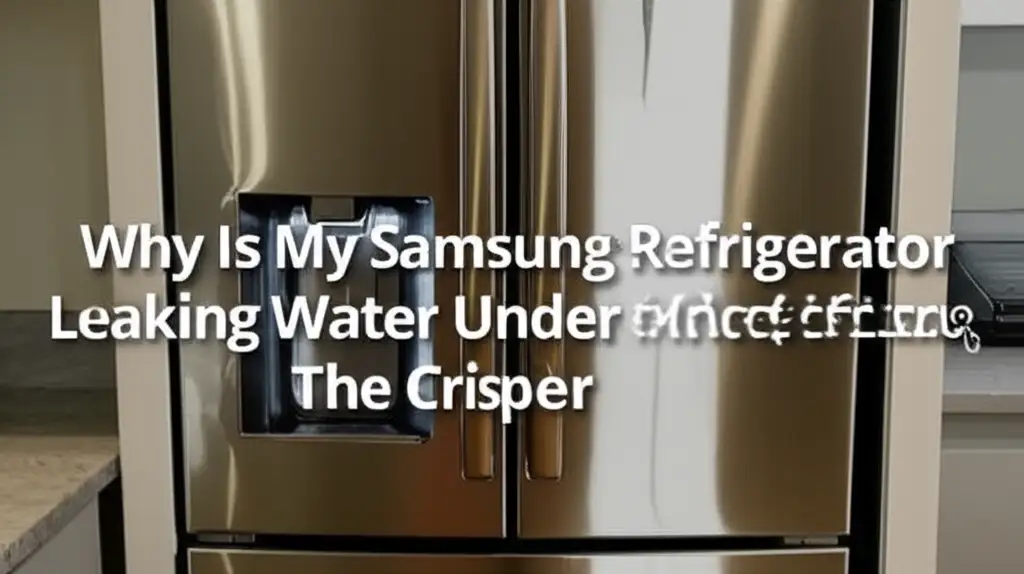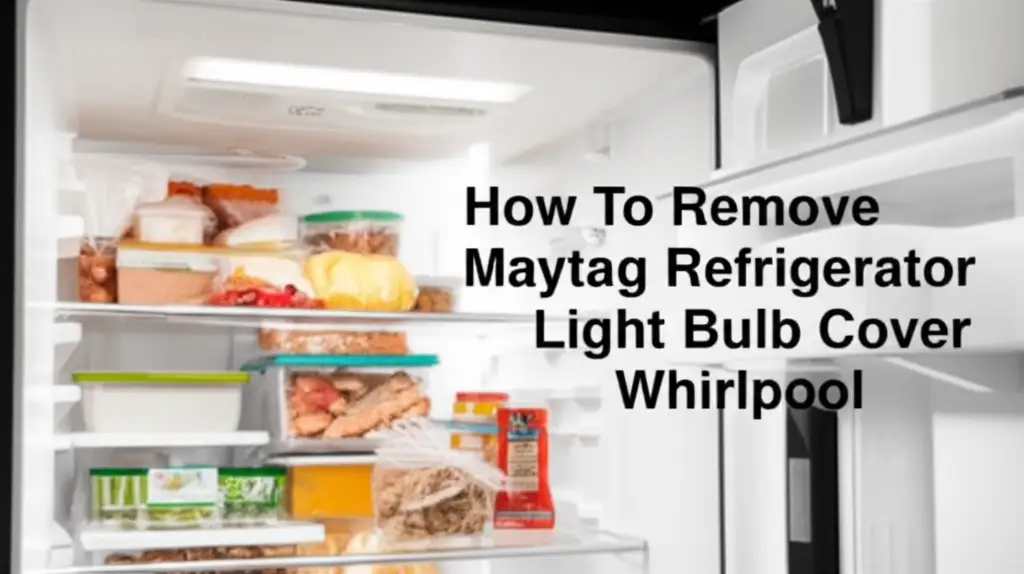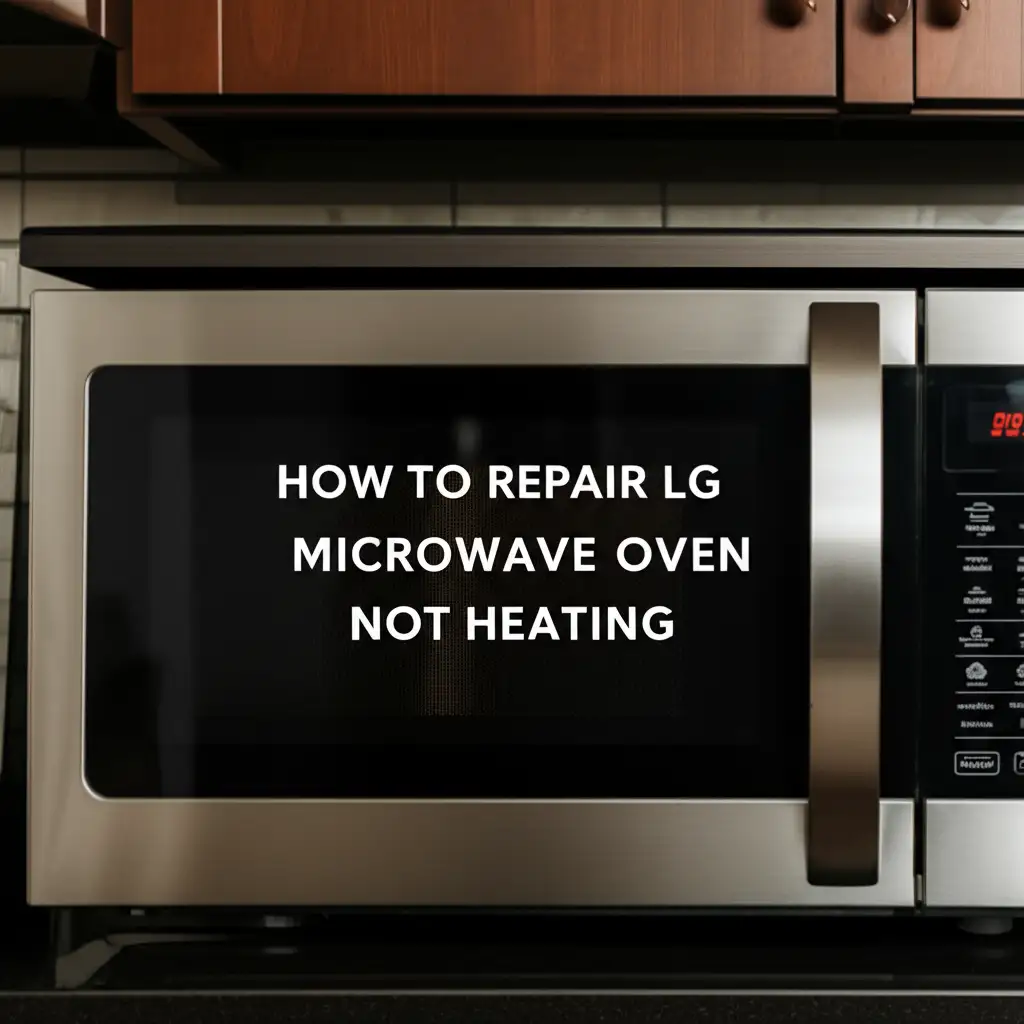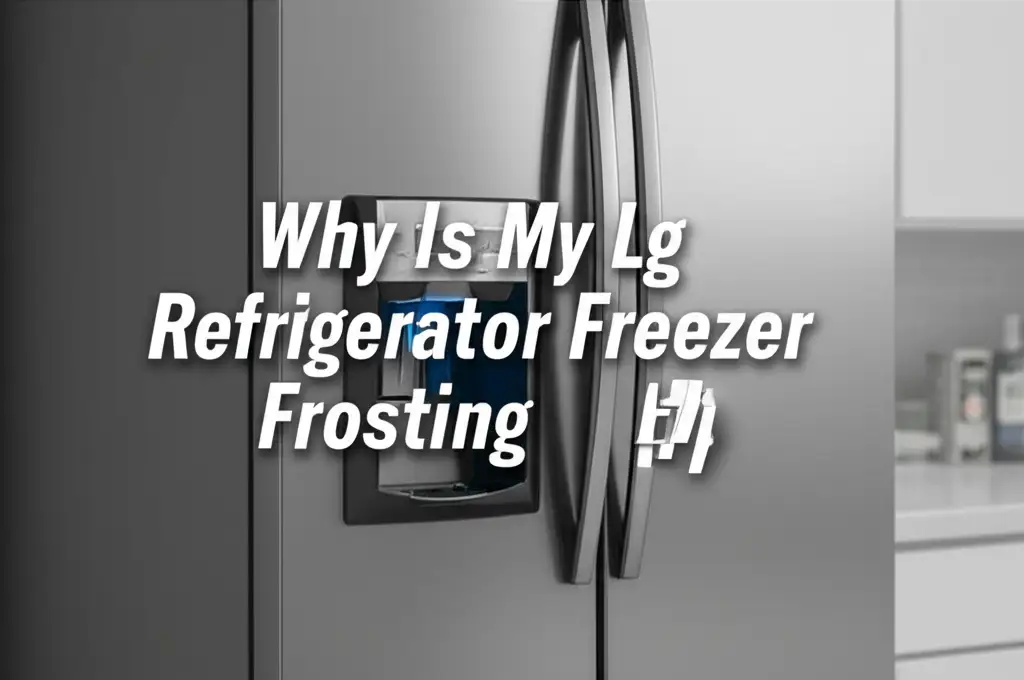· Todd Martin · Home Appliances · 18 min read
Why Does My Whirlpool Refrigerator Says Cooling Off
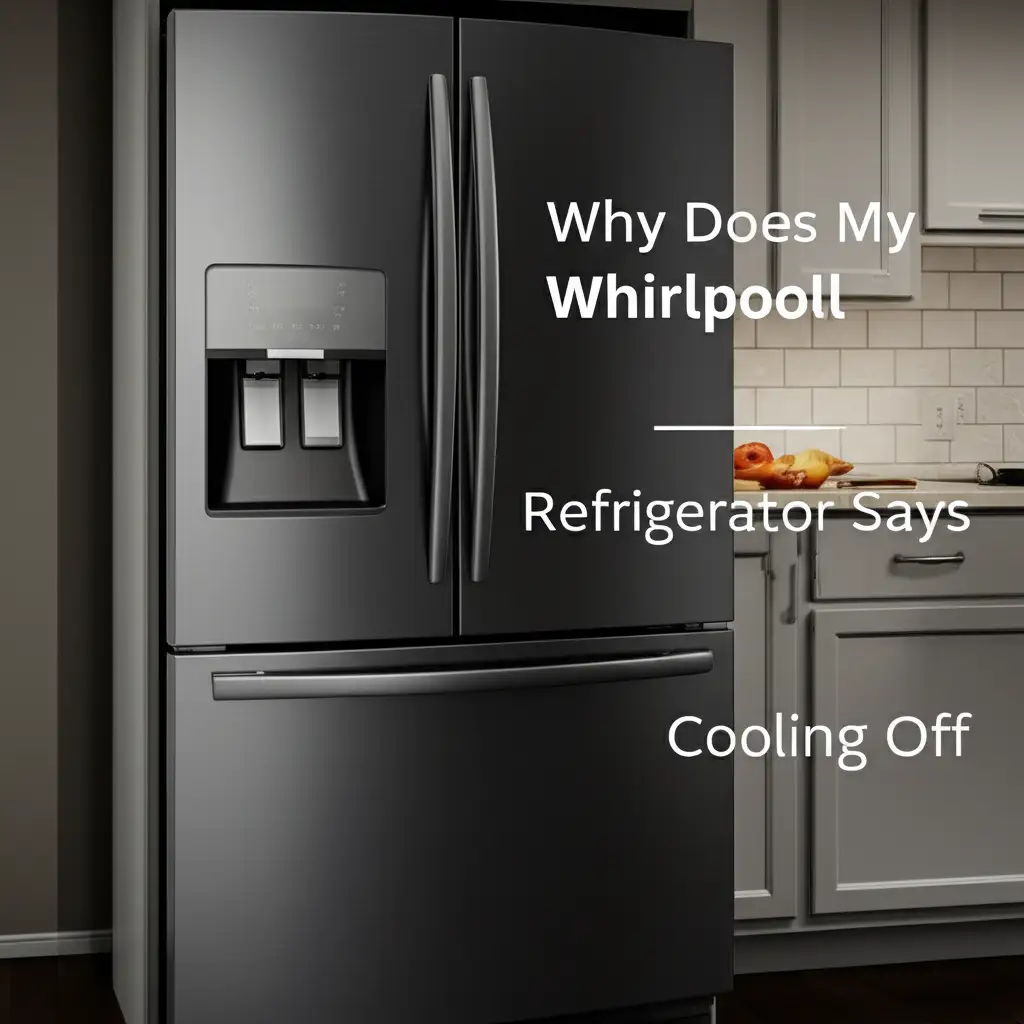
Why Your Whirlpool Refrigerator Says Cooling Off: A Comprehensive Guide
It’s a moment no homeowner wants: you open your refrigerator, expecting crisp, cold air, only to see a strange message. If your Whirlpool refrigerator says “Cooling Off,” you might feel a pang of worry. This message means your appliance has stopped its normal cooling cycle. It usually indicates a planned pause, like a defrost cycle, but it can also signal a problem. Understanding this message is crucial for keeping your food safe and your appliance working correctly.
This guide will explain why your Whirlpool refrigerator might display “Cooling Off.” We will cover common reasons like automatic defrost cycles and user settings. We will also look at potential issues such as fan failures, sensor problems, or clogged condenser coils. By the end, you will know how to troubleshoot the problem. You will also learn when it is time to seek professional help. Let’s get your Whirlpool refrigerator cooling again.
Takeaway: Restore Cooling to Your Whirlpool Refrigerator
- Check if the refrigerator is in a defrost cycle or display mode. This is often the simplest explanation.
- Verify temperature settings and ensure no buttons were pressed accidentally.
- Inspect and clean condenser coils and evaporator fan for blockages.
- Check the door seal for proper closure and look for ice buildup.
- Listen for the compressor and fans; unusual noises or silence suggest component issues.
- Consider a power reset to clear temporary glitches.
- Call a certified technician if basic troubleshooting fails to resolve the “Cooling Off” message.
Why Does My Whirlpool Refrigerator Say Cooling Off?
When your Whirlpool refrigerator says “Cooling Off,” it usually means the cooling system is intentionally paused. This can happen during an automatic defrost cycle to remove ice buildup, or it might be due to a user accidentally activating a “Sabbath mode” or “display mode.” Less commonly, it points to a problem with internal components like fans, sensors, or the control board.
Understanding the “Cooling Off” Message on Your Whirlpool Fridge
The “Cooling Off” message on your Whirlpool refrigerator can seem alarming. However, it often indicates a normal operation. Modern refrigerators use complex systems to maintain proper temperatures. These systems include scheduled maintenance cycles. One common cycle is the automatic defrost.
During a defrost cycle, the refrigerator’s cooling elements warm up. This melts any ice that has formed on the evaporator coils. The “Cooling Off” message may appear during this time. It informs you that the appliance is temporarily not actively cooling. This process is essential for efficiency. It prevents excessive ice buildup. Ice buildup can block airflow and reduce cooling performance. The duration of this cycle varies. It typically lasts 20 to 45 minutes. Your refrigerator will resume normal cooling afterward. This message is usually nothing to worry about. It simply communicates the current state.
Normal Operation vs. Malfunction Indication
It is important to tell the difference between normal operation and a malfunction. If “Cooling Off” appears briefly and then disappears, it is likely part of a normal defrost cycle. You might also notice a slight temperature rise inside the fridge during this time. This is normal. The refrigerator should return to its set temperature quickly.
However, if the message persists for several hours, or if your food starts to warm up significantly, it suggests a problem. This problem goes beyond a normal defrost cycle. It could mean the defrost cycle is stuck. It could also mean a component failure. Understanding this distinction helps you decide if action is needed. Your Whirlpool refrigerator is designed to keep food safe. Prolonged “Cooling Off” displays mean it is failing in this primary task.
Common Causes: Defrost Cycle and User Settings
The most frequent reasons your Whirlpool refrigerator says “Cooling Off” relate to its programmed functions or accidental user input. These are usually easy to check and resolve. Knowing about them can save you time and the cost of a service call. Let’s explore these common scenarios in detail.
Automatic Defrost Cycle in Progress
As mentioned, your Whirlpool refrigerator performs regular defrost cycles. This prevents ice from building up on the evaporator coils. Ice buildup makes the fridge work harder and consume more energy. When the defrost heater turns on, the cooling components temporarily shut down. The “Cooling Off” message can appear on the display. This is a normal part of the refrigerator’s maintenance.
You might notice the compressor stop running. There may be no fan noise from inside the freezer compartment. This state is temporary. The refrigerator’s design prevents food from warming too much during this short period. The cooling system resumes operation once the defrost cycle ends. This typically takes less than an hour. If you suspect a defrost cycle, give it some time. The message should clear on its own.
Accidental Activation of Sabbath Mode or Display Mode
Whirlpool refrigerators often come with special modes. Sabbath mode is one example. This mode turns off certain functions. These include internal lights, dispenser functions, and alarms. It also pauses the compressor for specific durations. The “Cooling Off” message might appear during Sabbath mode. It indicates that the normal cooling operations are altered.
Another mode is “Display Mode” or “Showroom Mode.” This mode allows the appliance to light up and appear functional, but it does not cool. This is for retail displays. If this mode is accidentally activated, your fridge will not cool. It will likely show “Cooling Off.” Check your appliance’s control panel. Look for specific button combinations to exit these modes. Consult your owner’s manual for exact instructions. For example, some models require holding a combination of “Light” and “Filter Reset” buttons for several seconds. If your refrigerator keeps turning on and off, or shows strange messages, checking these modes is a good first step. You can find more information on issues like this by checking articles on why your Whirlpool refrigerator keeps turning on and off.
Power Interruption or Reset
Sometimes, a brief power outage or a manual reset can trigger the “Cooling Off” message. When power returns, the refrigerator may go through a diagnostic cycle. During this cycle, it might temporarily stop active cooling. This is to ensure all systems are stable before resuming full operation. If you recently experienced a power flick, this could be the cause.
A simple power reset might also resolve the issue if it is a minor electronic glitch. To perform a power reset, unplug the refrigerator from the wall outlet. Wait for about 5 minutes. Then, plug it back in. This allows the internal control board to reset. This can clear any error codes or stuck modes. This is a common first troubleshooting step for many appliance problems.
Component Failures Affecting Cooling
If the “Cooling Off” message persists and is not related to a defrost cycle or user settings, internal component failures are likely. Several parts work together to cool your Whirlpool refrigerator. A problem with any one of them can stop the cooling process. We will look at the most common culprits.
Evaporator Fan Motor Issues
The evaporator fan motor plays a vital role. It circulates cold air from the evaporator coils throughout the refrigerator and freezer compartments. If this fan fails, cold air cannot reach the fresh food section. Even if the coils are cold, without airflow, cooling stops. This can trigger the “Cooling Off” message. You might notice the freezer compartment is cold, but the refrigerator side is warm.
Common signs of a faulty evaporator fan include:
- No fan noise: Listen for the fan running when you open the freezer door.
- Ice buildup on coils: Without air circulation, coils can freeze over excessively.
- Warm refrigerator compartment: Food spoils quickly if air is not circulating.
A bad motor may also make grinding or buzzing sounds. Replacing the evaporator fan motor usually requires removing panels inside the freezer. This is a task that some DIYers can handle. Ensure the power is disconnected before starting any repairs.
Condenser Fan Motor Problems
The condenser fan motor helps cool the compressor and condenser coils. These coils release heat from the refrigerant into your kitchen. If the condenser fan fails, heat builds up around the compressor. This causes the compressor to overheat and shut down. An overheated compressor cannot cool the refrigerator. This could lead to the “Cooling Off” display.
You can often find the condenser fan near the bottom rear of the refrigerator. Check if the fan blades are obstructed by debris or pet hair. Clear any blockages. If the blades spin freely but the fan does not run when the compressor should be active, the motor may be faulty. A malfunctioning condenser fan can sometimes lead to issues where your side-by-side refrigerator is not cooling effectively. For general issues where your side-by-side refrigerator is not cooling, the condenser fan is a key area to check.
Faulty Thermistor or Temperature Sensor
The thermistor, or temperature sensor, monitors the temperature inside the refrigerator. It sends this information to the control board. The control board uses this data to decide when to cycle the compressor and fans. If the thermistor is faulty, it might send incorrect readings. For example, it might tell the control board that the refrigerator is colder than it is. This would cause the cooling system to shut down prematurely. This can result in the “Cooling Off” message.
A faulty thermistor can cause inconsistent cooling. Your refrigerator might cycle on and off too frequently. It might also not cool at all. Testing a thermistor usually involves using a multimeter to check its resistance. This resistance changes with temperature. If the readings are out of range, the thermistor needs replacement. This sensor is often located near the fresh food return air vent.
Defective Compressor
The compressor is the heart of your refrigerator’s cooling system. It compresses refrigerant gas, which then moves through the coils to remove heat. If the compressor is defective, it cannot circulate refrigerant. This means the cooling process stops entirely. A “Cooling Off” message could indicate a compressor failure. This is often a serious and costly repair.
Signs of a faulty compressor include:
- No humming sound: The compressor normally makes a low hum when running.
- Warm refrigerator and freezer: Both compartments will fail to cool.
- Clicking noises: Some compressors make clicking sounds before failing. This is a starting relay issue.
A compressor problem usually requires a professional appliance technician. They have the specialized tools and training. They can properly diagnose and replace this component. They also handle the refrigerant safely.
Maintaining Optimal Cooling Performance
Regular maintenance is key to preventing your Whirlpool refrigerator from saying “Cooling Off.” Keeping certain components clean and free from obstruction ensures efficient operation. These steps help your fridge maintain stable temperatures and avoid common cooling issues.
Cleaning Condenser Coils
Dirty condenser coils are a very common reason for poor cooling performance. These coils are located at the bottom or back of your refrigerator. They release heat from the refrigerant into the room. If they are covered in dust, pet hair, and debris, they cannot dissipate heat effectively. This makes the compressor work harder, drawing more power and increasing wear. Eventually, the refrigerator may struggle to cool. It could even display a “Cooling Off” message as a protection mechanism or because it simply cannot achieve the set temperature.
I recommend cleaning your condenser coils at least once or twice a year. You will need to pull the refrigerator away from the wall. Then, unplug it from the power outlet. Use a coil brush or a vacuum cleaner with a brush attachment. Carefully remove all dust and debris from the coils. This simple task can significantly improve cooling efficiency. It can also extend your appliance’s life. If you have a Whirlpool side-by-side model, learning how to clean your Whirlpool side-by-side refrigerator coils is an excellent maintenance step.
Checking Door Seals and Gaskets
The door seals, or gaskets, create an airtight seal around the refrigerator and freezer doors. This seal keeps cold air inside and warm air out. If the seals are cracked, torn, or loose, cold air can escape. Warm, humid air enters the refrigerator. This makes the cooling system work continuously to try to maintain the temperature. This constant running can lead to frost buildup or overworking the components. The “Cooling Off” message might appear if the system cannot maintain temperature.
To check your door seals, perform a simple paper test. Close the door on a piece of paper. If you can easily pull the paper out, the seal is weak. Inspect the entire perimeter of both doors. Look for visible gaps or damage. Clean the gaskets regularly with mild soap and water. This keeps them pliable. If they are damaged, replace them to ensure proper sealing. Proper door sealing prevents your Whirlpool refrigerator from needing to work overtime. It also avoids moisture issues, which can cause water in the bottom of the fridge. For more on this, you might explore why your Whirlpool refrigerator has water in the bottom. Ensuring a tight seal is also essential to prevent your Whirlpool refrigerator from continuously saying the door is open.
Ensuring Proper Airflow Inside
Good airflow within the refrigerator compartment is essential for even cooling. Overpacking your refrigerator can block vents. This prevents cold air from circulating properly. Cold air needs to move freely around food items. If air vents are blocked by food containers, cold spots and warm spots can develop. The temperature sensor might not get accurate readings. This can cause the control board to incorrectly signal “Cooling Off” or reduce cooling effort.
Avoid overfilling your refrigerator shelves. Leave space between items. Make sure food packages do not block the air vents, especially those located at the back of the compartments. Also, ensure the refrigerator itself has enough space around it. Do not push it too close to the wall. Keep at least an inch or two of space on the sides and back. This allows the condenser coils to dissipate heat properly. Proper airflow is simple to check and can significantly impact cooling efficiency.
Advanced Troubleshooting: Control Boards and Power Issues
Sometimes, the “Cooling Off” message points to more complex electrical or electronic problems. These issues often require a deeper understanding of the refrigerator’s systems. While some checks are possible for homeowners, others may necessitate professional help.
Control Board Malfunctions
The main control board acts as the brain of your Whirlpool refrigerator. It processes information from sensors. It then sends commands to components like the compressor, fans, and defrost heater. If the control board malfunctions, it can send incorrect signals. It might erroneously display “Cooling Off.” It could also fail to initiate cooling, even when needed.
Signs of a faulty control board can be erratic behavior. This includes lights flickering, strange display messages, or components turning on and off randomly. Sometimes, a power surge can damage the control board. If you have tried all other troubleshooting steps and the “Cooling Off” message persists, the control board might be the culprit. Replacing a control board is a complex task. It often requires specific part numbers and can be expensive. It is best left to an experienced technician. They can diagnose the issue correctly and ensure proper installation. This issue shares similarities with the “Refrigeration Cooling Is Off” message seen on KitchenAid models. Knowing why your KitchenAid refrigerator says “Refrigeration Cooling Is Off” can offer relevant insights.
Power Supply Issues
A stable power supply is critical for any appliance. Fluctuations in voltage or a partial power failure can disrupt your refrigerator’s operation. If your Whirlpool refrigerator is not receiving consistent power, it might enter a “Cooling Off” state. This protects its components from damage. This is a less common cause for the message itself, but it can certainly lead to a lack of cooling.
Check the power outlet. Plug another appliance into the same outlet to ensure it is working correctly. Avoid using extension cords. They can cause voltage drops or not provide enough power. Inspect the refrigerator’s power cord for any visible damage. If your refrigerator frequently trips the circuit breaker, it might indicate an underlying electrical problem with the appliance or your home’s wiring. Understanding why your Whirlpool refrigerator keeps tripping the breaker can help identify power-related issues. If you suspect an electrical issue, consult a qualified electrician. They can check your home’s wiring and the outlet.
Software Glitches and Firmware Updates
Like many modern appliances, some Whirlpool refrigerators have software or firmware that controls their functions. Rarely, a software glitch can cause the “Cooling Off” message to appear. This might happen after a power interruption or if the system gets stuck. Sometimes, a manufacturer might release firmware updates. These updates can fix known bugs.
A simple power reset (unplugging for 5-10 minutes) can often clear minor software glitches. If your refrigerator is a smart model connected to Wi-Fi, check the Whirlpool app. See if there are any error codes or suggested diagnostics. Some smart refrigerators allow firmware updates via the app. While rare, checking for updates or performing a hard reset can sometimes resolve these electronic issues without needing a technician.
When to Call a Professional for Whirlpool Refrigerator Repair
While many “Cooling Off” issues can be resolved with basic troubleshooting, there are times when professional help is essential. Knowing when to call a technician can save you time, prevent further damage, and ensure safe repairs.
Persistent “Cooling Off” Message
If your Whirlpool refrigerator continuously displays “Cooling Off” for several hours, and you have ruled out a normal defrost cycle or user settings, it is a clear sign of a problem. A healthy refrigerator should resume cooling quickly after a defrost. If it stays in this mode, or if the food inside is clearly warming up, do not delay. This persistence indicates a deeper issue with a component. It means your refrigerator is not performing its basic function.
Loud or Unusual Noises
Refrigerators make certain sounds, like a low hum from the compressor or the gentle whir of fans. However, if you hear loud grinding, buzzing, clicking, or rattling noises, this often signals a mechanical failure. These noises might come from a failing compressor, a fan motor with bad bearings, or other internal parts. Unusual noises coupled with the “Cooling Off” message are strong indicators that a component is failing and needs expert attention.
Visible Damage or Leaks
If you notice visible damage to components, such as a broken wire, a burnt smell, or refrigerant leaks, it is time to call a professional. Refrigerant is a chemical. It needs careful handling. A leak not only affects cooling but can also be harmful. Similarly, if you see water pooling around your refrigerator, or if your Whirlpool refrigerator has water in the bottom, this might be linked to a clogged defrost drain or other issue affecting the cooling system. Issues like water in the bottom of your Whirlpool refrigerator can sometimes point to problems that a technician can quickly diagnose. These visible signs often indicate complex problems that are beyond simple DIY fixes.
Lack of Cooling After Troubleshooting
You have cleaned the coils, checked the door seals, reset the power, and confirmed no special modes are active. Still, your Whirlpool refrigerator says “Cooling Off,” and the internal temperature is rising. At this point, the problem likely lies with internal components like the compressor, evaporator, or main control board. These repairs are complex. They require specialized tools, diagnostic equipment, and often specific refrigerant handling licenses. Do not attempt these repairs yourself if you lack the expertise. Incorrect repairs can cause more damage or create safety hazards. A certified appliance technician can accurately diagnose the issue. They can then perform the necessary repairs safely and efficiently.
Preventive Measures to Avoid Future Cooling Problems
Prevention is always better than cure, especially with major appliances like your refrigerator. Taking simple, regular steps can significantly reduce the chances of your Whirlpool refrigerator displaying “Cooling Off” in the future. These practices promote efficiency and extend the life of your appliance.
Regular Cleaning and Maintenance Schedule
Establish a routine for cleaning your refrigerator. This goes beyond wiping down spills. Focus on the critical components that impact cooling.
- Condenser Coils: Clean these at least twice a year, or more often if you have pets. Dust and pet hair accumulate quickly. They act as insulation, trapping heat and making the compressor work harder.
- Door Gaskets: Wipe down door seals monthly with warm, soapy water. This removes food debris and prevents them from sticking or becoming brittle. A clean, pliable gasket ensures a tight seal.
- Interior Vents: Periodically check that no food items or containers block the internal air vents. Good airflow is essential for consistent temperatures throughout the fridge and freezer.
Consistent cleaning helps maintain optimal performance. It also alerts you to minor issues before they become major problems.
Proper Refrigerator Placement and Airflow
Where you place your refrigerator matters. Ensure it has enough space around it for proper ventilation.
- Back and Sides: Allow at least an inch or two of space between the refrigerator’s back and sides and the wall or cabinetry. This enables heat from the condenser coils to dissipate properly into the room.
- Location: Avoid placing the refrigerator in direct sunlight or next to heat-generating appliances like ovens or dishwashers. External heat makes the refrigerator work harder to cool its interior.
Good ventilation prevents overheating. Overheating can strain the compressor and other cooling components. It can also lead to protective shutdowns, potentially causing the “Cooling Off” message.
Avoiding Overloading and Proper Food Storage
While it might seem counterintuitive, an overloaded refrigerator can hinder cooling efficiency.
- Overpacking: Do not pack your refrigerator too tightly. Air needs to circulate freely around food items. Blocked vents or packed shelves prevent cold air from reaching all areas. This creates warm spots and forces the compressor to run more often.
- Hot Food: Avoid putting hot food directly into the refrigerator. Let it cool down to room temperature first. Adding hot food significantly raises the internal temperature. This makes the cooling system work overtime to bring it back down.
Proper food storage ensures efficient cooling. It also helps your refrigerator maintain stable temperatures. This reduces the stress on its components.


